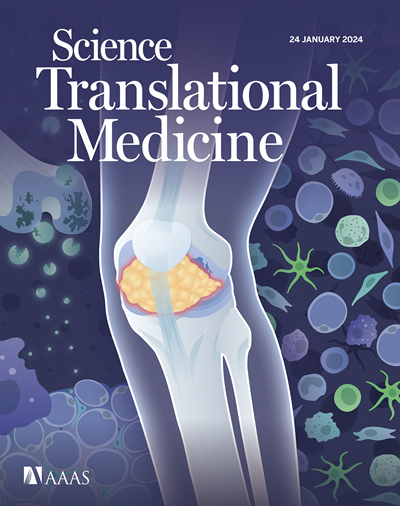以转铁蛋白受体为靶点,通过哺乳动物血脑屏障转运反义寡核苷酸。
IF 15.8
1区 医学
Q1 CELL BIOLOGY
引用次数: 0
摘要
反义寡核苷酸(ASO)是治疗各种神经系统疾病的有前途的疗法。然而,反义寡核苷酸无法轻易穿过哺乳动物的血脑屏障(BBB),因此需要经体内递送至中枢神经系统(CNS)。在这里,我们设计了一种与人类转铁蛋白受体1(TfR1)结合的分子--寡核苷酸转运载体(OTV),用于在人类TfR基因敲除(TfRmu/hu KI)小鼠和非人灵长类动物体内转运ASO。向 TfRmu/hu KI 小鼠静脉注射和全身给药 OTV 可持续敲除小鼠中枢神经系统多个区域和多种细胞类型(包括内皮细胞、神经元、星形胶质细胞、小胶质细胞和少突胶质细胞)的 ASO 靶 RNA Malat1。此外,全身给药 OTV 还能敲除小鼠股四头肌和心肌中的 Malat1 RNA,而仅使用寡核苷酸很难敲除这些肌肉。与二价高亲和力 TfR 抗体相比,全身给药 OTV 使 ASO 在 TfRmu/hu KI 小鼠中枢神经系统中的生物分布更均匀,对 Malat1 RNA 的基因敲除更强。在犬科猕猴中,针对 MALAT1 的 OTV 在灵长类中枢神经系统中显示出强大的 ASO 释放能力,与相同的非共轭 ASO 鞘内给药相比,它能实现更均匀的生物分布和 RNA 靶点敲除。我们的数据支持将系统递送 OTV 作为跨 BBB 递送治疗性 ASO 的潜在平台。本文章由计算机程序翻译,如有差异,请以英文原文为准。
Targeting the transferrin receptor to transport antisense oligonucleotides across the mammalian blood-brain barrier
Antisense oligonucleotides (ASOs) are promising therapeutics for treating various neurological disorders. However, ASOs are unable to readily cross the mammalian blood-brain barrier (BBB) and therefore need to be delivered intrathecally to the central nervous system (CNS). Here, we engineered a human transferrin receptor 1 (TfR1) binding molecule, the oligonucleotide transport vehicle (OTV), to transport a tool ASO across the BBB in human TfR knockin (TfRmu/hu KI) mice and nonhuman primates. Intravenous injection and systemic delivery of OTV to TfRmu/hu KI mice resulted in sustained knockdown of the ASO target RNA, Malat1, across multiple mouse CNS regions and cell types, including endothelial cells, neurons, astrocytes, microglia, and oligodendrocytes. In addition, systemic delivery of OTV enabled Malat1 RNA knockdown in mouse quadriceps and cardiac muscles, which are difficult to target with oligonucleotides alone. Systemically delivered OTV enabled a more uniform ASO biodistribution profile in the CNS of TfRmu/hu KI mice and greater knockdown of Malat1 RNA compared with a bivalent, high-affinity TfR antibody. In cynomolgus macaques, an OTV directed against MALAT1 displayed robust ASO delivery to the primate CNS and enabled more uniform biodistribution and RNA target knockdown compared with intrathecal dosing of the same unconjugated ASO. Our data support systemically delivered OTV as a potential platform for delivering therapeutic ASOs across the BBB.
求助全文
通过发布文献求助,成功后即可免费获取论文全文。
去求助
来源期刊

Science Translational Medicine
CELL BIOLOGY-MEDICINE, RESEARCH & EXPERIMENTAL
CiteScore
26.70
自引率
1.20%
发文量
309
审稿时长
1.7 months
期刊介绍:
Science Translational Medicine is an online journal that focuses on publishing research at the intersection of science, engineering, and medicine. The goal of the journal is to promote human health by providing a platform for researchers from various disciplines to communicate their latest advancements in biomedical, translational, and clinical research.
The journal aims to address the slow translation of scientific knowledge into effective treatments and health measures. It publishes articles that fill the knowledge gaps between preclinical research and medical applications, with a focus on accelerating the translation of knowledge into new ways of preventing, diagnosing, and treating human diseases.
The scope of Science Translational Medicine includes various areas such as cardiovascular disease, immunology/vaccines, metabolism/diabetes/obesity, neuroscience/neurology/psychiatry, cancer, infectious diseases, policy, behavior, bioengineering, chemical genomics/drug discovery, imaging, applied physical sciences, medical nanotechnology, drug delivery, biomarkers, gene therapy/regenerative medicine, toxicology and pharmacokinetics, data mining, cell culture, animal and human studies, medical informatics, and other interdisciplinary approaches to medicine.
The target audience of the journal includes researchers and management in academia, government, and the biotechnology and pharmaceutical industries. It is also relevant to physician scientists, regulators, policy makers, investors, business developers, and funding agencies.
 求助内容:
求助内容: 应助结果提醒方式:
应助结果提醒方式:


